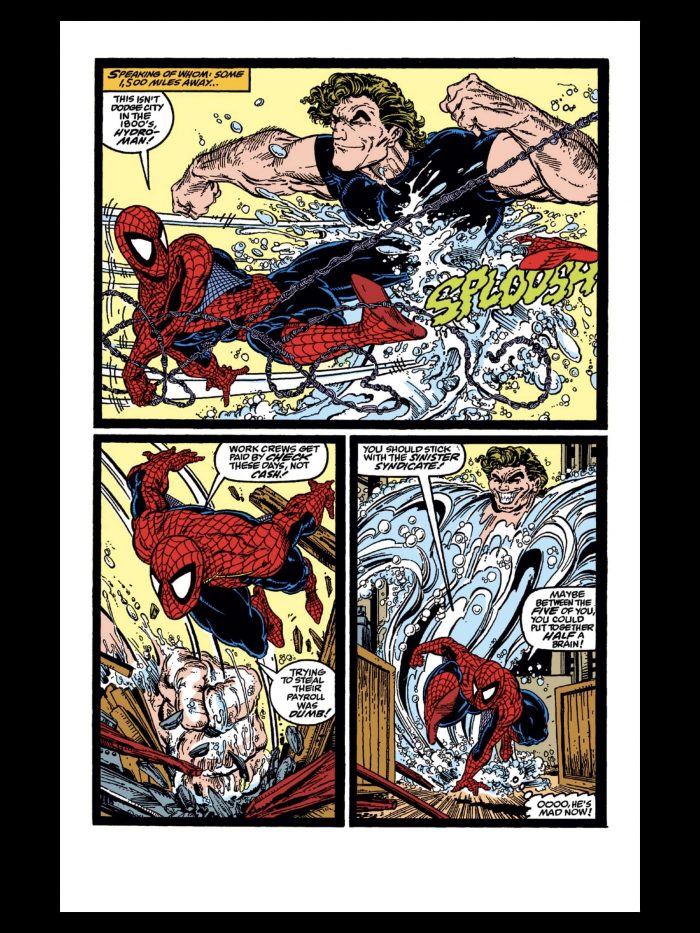How ‘Spider-Man: Far from Home’ Draws from Comics History and What Its Ending Teases Mean for the MCU

Face front, true believers: there’s a new Spider-Man movie in theaters. At twenty-three films and counting, the Marvel Cinematic Universe has been going on long enough now that it has its own history and needn’t be a slave to comics history (not that it ever was). Reviews have nonetheless pegged Spider-Man: Far from Home as one of the more comic book-y entries in the MCU.
While it strays from its source material in some notable ways, leaning into a more tech-friendly interpretation of the Spider-Man mythos, there are a number of plot points in the film that do draw from Marvel Comics tradition. Sometimes they’re just subtle nods, Easter eggs for eagle-eyed comic readers to spot. Other times, having knowledge of movie and comics history may be essential for understanding the significance of certain moments, including those that we see play out in the requisite mid-credits scene and post-credits scene.
If anything left you scratching your head in Spider-Man: Far from Home, or you just want to have a deeper appreciation for the layers of history behind the web-slinger’s Old-World summer adventure in Europe, then don your best fishbowl helmet and let’s take a spoiler-filled dive into those right now.
Sandman, Hydro-Man, and the Elementals
Beginning with its opening scene, Far from Home introduces us to a series of CG monsters with elemental powers. Quentin Beck, AKA Mysterio (Jake Gyllenhaal) eventually explains that they are “creatures formed from the primary elements: Air, Fire, Water, Earth.”
Creatively dubbed the Elementals (because what else are you going to call them? Planeteers?) these beings are an extremely loose adaptation of four Marvel Comics villains. They take their name from a lesser-known team in the comics but the members are switched out here for villains with corresponding powers who have more of a history with Spider-Man.
Sandman is relegated to a cameo in the desert at the beginning of the movie. Nick Fury and Maria Hill are in Mexico when they encounter the first of the Elementals. At this point, we’ve seen the Sony logo onscreen but the Marvel Studios logo hasn’t even popped up yet. It’s just a short prologue sequence that introduces Beck as he fights back the living sandstorm of the Earth Elemental and seemingly saves the day.
In the comics, Sandman was a member of the Sinister Six who tried to leave the criminal fraternity and go straight. He straddled the line between hero and villain and was enough of an A-lister among Spidey’s rogues that Sam Raimi wanted to use the character as the main villain for Spider-Man 3 (until the studio began pushing for fan-favorite baddie Venom to be included). Raimi requisitioned actor Thomas Haden Church, who was not far removed from his Sideways Oscar nomination at the time, to play the character opposite Tobey Maguire.
As the MCU moves away from already-used villains and goes more tech-oriented with its vision of Spider-Man, it looks like its version of Sandman is fated to be more of an Easter egg. Blink, and you’ll miss the Earth Elemental’s connection to comics history.
Hydro-Man, whose real name in the comics was Morris Bench, also gets the Easter egg treatment. This character was definitely a B-lister: sort of a waterized, or watered down, version of Sandman, complete with the same slangy syntax and blue-collar-criminal personality type. (“Ain’t you heard? I ain’t human no more.”)
The two kindred crooks fought over the same “floozy” in Amazing Spider-Man #217 (“Here’s mud in your eye, Spidey!”) but were able to put aside their differences long enough to team up against Spider-Man. At the end of the issue, their bodies combined to become the lumbering Mud-Thing. This mostly mindless creature shares more in common with the Elementals that we see onscreen in Far from Home, especially the last one, which is a combination of the other three.

Hydro-Man even filled the Sandman role in the Sinister Syndicate, an off-brand version of the Sinister Six. His most memorable solo appearance in the early Modern Age of comics was perhaps Amazing Spider-Man #315, where he came to life via Todd McFarlane art.
Even in an issue where he graced the cover, however, Hydro-Man was reduced to a three-page encounter with Spider-Man before he retreated down a storm drain. In Far from Home, Hydro-Man shows up in the canals of Venice, the perfect place for a water-based villain to wreak havoc.
Peter dons a Venetian mask to fight him alongside Mysterio while bystanders remark on how they are “kicking that water’s ass.” After they have defeated him, Flash Thompson sees a Buzzfeed article on his smartphone making the dubious claim that an experimental underwater generator imbued a man named Morris Bench with hydro powers. It’s a cute acknowledgement of Hydro-Man’s comics origin, but as it turns out, it’s not true, because the Water Elemental is merely a hologram.
The Fire Elemental, which attacks the Ferris wheel in Prague, certainly looks molten, if not quite like Molten Man from the comics. He’s got his own Funko Pop! figure already, as does Hydro-Man, but really, it’s only the barest visual nod that links this Elemental to his comics counterpart.
According to the MCU Wiki, the final Elemental is based on Whirlwind, but honestly, if you hadn’t told me that, I wouldn’t have guessed it, either. In the comics, Whirlwind was more of an Avengers villain. In the movie, he (technically, it) is depicted as a raging cloud, made up of all the other Elementals combined.

Mysterio, Master of Illusions
Mysterio has one of the more comics-accurate villain costumes that we’ve seen in the MCU thus far. Having a special-effects artist — like Quentin Beck was in the comics — be the villain might be a bridge too far in terms of movie-artifice reminders, so the Mysterio that we see in Far from Home gets a high-tech makeover that sees him casting illusions with a holographic system. There’s still a wink at Hollywood moviemaking magic when we see him strutting around in a mo-cap suit toward the end.
The way the film withholds Mysterio’s true nature, playing it as a rug to be pulled later on, is in accordance with the late reveal in several comic stories. In Amazing Spider-Man #311, another issue with Todd McFarlane art, Mysterio tricked Spider-Man into thinking that he had failed to save a mugging victim from being killed. It was only when Spider-Man returned to the scene later to retrieve his camera (the one he used in his civilian identity as a Daily Bugle photographer) that he realized the whole incident had been a trick.
Mysterio has also messed with the head of other Marvel heroes, not just Spider-Man. In the “Guardian Devil” storyline, written by filmmaker Kevin Smith and pencilled by future Marvel Comics Editor-in-Chief Joe Quesada, Mysterio tried to drive Daredevil insane by means of an elaborate scheme involving an immaculately conceived child who was either the Second Coming or the Antichrist.
In “Old Man Logan,” which partially inspired the last Wolverine film, Logan, Mysterio also succeeded in fooling Wolverine into killing the X-Men by making him think they were supervillains attacking the X-Mansion. This took place in an alternate future, not the Earth-616 timeline. (There’s another Easter egg in Far from Home where Mysterio refers to the MCU as Earth-616.)
The page where Mysterio revealed himself to Wolverine was a gut punch. With the X-Men dead and Jubilee’s fresh corpse lying bloody in arms, Wolverine could only look on in absolute shock as the villain said, “My name is Mysterio, the master of illusions. My thanks on behalf of the criminal community.”
Continue Reading Spider-Man Far From Home and Comics >>
The post How ‘Spider-Man: Far from Home’ Draws from Comics History and What Its Ending Teases Mean for the MCU appeared first on /Film.
from /Film https://ift.tt/2XqoaWf

No comments: